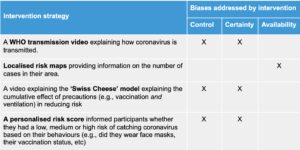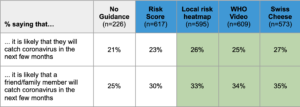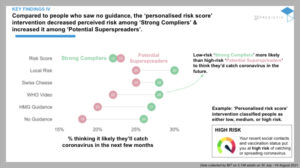In our previous blog, we shared three key insights about how people perceive coronavirus risk.
First, a sizable minority still don’t appreciate that coronavirus is an airborne virus, which leads them to underestimate the role of ventilation.
Second, people do have a good sense of the relative risk of situations. For example, they know that a nightclub is riskier than a visit to the park. Finally, the “spread of risk” is unevenly distributed: a small proportion of people (〜20%) account for the majority of risk of spreading and catching coronavirus (〜83%).
But, what factors affect how people perceive risk? And can we design interventions that help to make risk perception more accurate? We conducted an online experiment in partnership with the UK Cabinet Office to find out.
Factors affecting risk perception
Lots of research shows that people do not calculate risk in a purely rational way. Different biases and ‘heuristics’ – simple rules of thumb we use to make decisions – are part of the mix. For this research we considered three common heuristics that influence how we perceive risk. They are: certainty, control and availability.
The certainty heuristic describes our tendency to reject options associated with uncertainty or where the risks are invisible. It’s one reason why people tend to think that nuclear power is more dangerous than coal power. For coronavirus, there is no visible way to assess transmission risk, and so it’s hard to assess how risky a situation is.
The controllability heuristic describes our tendency to see things as less risky if you feel in control while doing it. Despite it being 75 times more dangerous, people think driving is safer than flying because they are in the driving seat. With coronavirus, people may believe that there is no means of controlling the likelihood of infection. As a result, they may avoid social contact despite being able to reduce risk through vaccination or meeting outdoors.
Finally, the availability heuristic accounts for our tendency to judge likelihood of an event by how easy it is to retrieve examples. The powerful images in the media of exceptional events – like shark attacks – leads people to overestimate their frequency. Media reporting on the coronavirus deaths may explain why people overestimate the fatality rate.
How can we make risk perception more accurate?
We conducted an online experiment with 3,200 adults from England over the summer to test ways to make risk assessments more accurate. Enabling people to assess their risk accurately will be essential as we increasingly rely on individual risk based decisions – shaped by government guidance – to manage the pandemic.
Our hypothesis on how to improve accuracy was simple. If people understand how coronavirus spreads, the risk to themselves and effective mitigation strategies, they’ll make better judgments. To test it, we randomised participants to see one of four interventions designed to improve risk perception:

What did we find? All interventions increased people’s perception of risk relative to existing guidance or no guidance. For example, on average 21% of people who saw no guidance thought it likely they would catch coronavirus in the next few months compared with an average of 25% across the four interventions. It’s worth noting that this baseline risk is obviously too high. (Green shading in the table below identifies the statistically significantly highest – or joint highest – values within a row.)

However, increasing risk perception across the population may no longer be required. That’s because the UK needs to balance two priorities: enabling a safe opening of society that will support our recovery from the pandemic and reducing transmission risk to avoid overwhelming the NHS.
To do that, two groups are particularly important. Firstly, people who are very concerned about coronavirus and have not resumed normal socialising (we call this group “strong compliers”). Secondly, people who are taking few or no precautions (we call this group “potential superspreaders”).
When we broke down our results by strong compliers and potential superspreaders we found that the personalised risk score was the only arm to shift risk perception in these groups in the desired directions. It reduced risk perception among the strong compliers while increasing it among potential superspreaders.

We think this is a promising result that points to the potential for personalised risk information. Still, the effects of our intervention were modest. And given that ‘potential superspreaders’ are disproportionately likely not to engage with government messaging, finding opportunities to reach them is likely to be hard.
We’ll need to be creative in finding touchpoints to engage potential superspreaders. This might involve integrating assessments of personalised risk into touchpoints this group has with HMG: visits to GPs, the ordering process for lateral flow or PCR tests. This is an important endeavour: changing the behaviour of “potential superspreaders” may be one of the most important factors determining whether the UK navigates the challenges of autumn and winter successfully.






